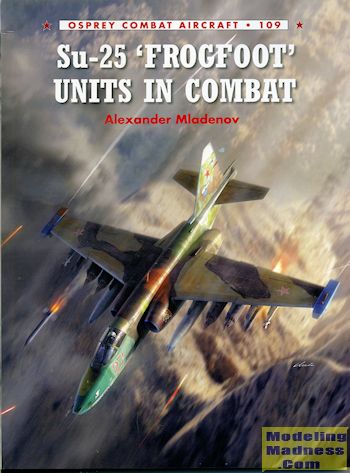 Though
often touted as a copy of the Northrop YA-9A, the Su-25 was very much a home
grown design that was produced to meet the needs for a dedicated ground attack
aircraft. As the Soviets tend to be rather conservative in many of their
designs, what came off the boards was a rather mundane looking twin engine jet
with the engines close to the fuselage as well as long wings with many hard
points and a large tailplane.
Though
often touted as a copy of the Northrop YA-9A, the Su-25 was very much a home
grown design that was produced to meet the needs for a dedicated ground attack
aircraft. As the Soviets tend to be rather conservative in many of their
designs, what came off the boards was a rather mundane looking twin engine jet
with the engines close to the fuselage as well as long wings with many hard
points and a large tailplane.
Much of this design was to ensure survivability of the plane and pilot with
the cockpit being basically an armored tub. The large flight surfaces meant that
bits could be blown away and the plane still fly. Same with the engines so close
to the fuselage. The loss of one power plant would not adversely affect the
handling of the aircraft.
As with all new designs, there were bugs to work out, especially one
concerning the controls. They were not powered and there were several instances
of the pilot not being able to properly control the plane at high speed. There
were also a few engine issues as well as those with avionics, but as always
happens, most of these were cured in short order.
The Su-25 had the benefit of being able to be developed in combat. About the
time the pre-production planes were being built, the Soviets were in a major war
in Afghanistan. No better way to test aircraft and systems that to use them in
combat. Much was learned from the several months in country and this was passed
along to the production line.
Not unexpectedly, the majority of the book is on the plane's use in combat by
the Soviets in Afghanistan. It was here that crews served for one year tours in
their fight against the Mujahedeen. Initially, the planes operated at low level
and were quite successful. However, with the enemy being supplied with shoulder
mounted surface to air missiles, down low became more and more dangerous. This
required greater use of stand off weapons such as laser guided bombs. This led
to improved avionics and the Su-25 has been continually upgraded as the years
have gone by.
The break up of the Soviet Union saw a division of the Frogfoot fleet with
many of the ex-Soviet republics having access to the aircraft and local aircrew.
As we have seen recently in the Ukraine, the Russians continued their aggression
in conflicts in Georgia, Chechnya, South Ossetia and other places that used to
be part of the Soviet Union.
Of course, the Frogfoot found its way to other nations with Iraq probably
being the biggest user of the type. While it was use with some success against
Iran in their war, it was only a target during later conflicts and most were
destroyed on the ground. It was also used in Angola, Yemen, Ivory Coast, Peru
and Macedonia to name a few. Ironically, ex-Iraqi Su-25s have been refurbished
by Iran and sent back to Iraq to help with the fight against ISIL.
In all, it is a great books with lots of photos, most in color, as well as a
plethora of great full color profiles. Just the sort of thing that both
historians and modelers love to see. A great read that I found quite interesting
and I know you will as well.
April 2015
For more on the complete line of Osprey books,
visit http://ospreygrp.com
or contact them at Osprey Direct, PO Box 140, Wellingborough, Northants,
NN8 2FA, UK. In the US, it is
Osprey Direct at 44-02 23rd St, Suite 219, Long Island City, NY 11101., where you can
get a catalogue of available books.
If you would like your product reviewed fairly and
fairly quickly, please
contact the editor or see other details in the
Note to
Contributors.
 Though
often touted as a copy of the Northrop YA-9A, the Su-25 was very much a home
grown design that was produced to meet the needs for a dedicated ground attack
aircraft. As the Soviets tend to be rather conservative in many of their
designs, what came off the boards was a rather mundane looking twin engine jet
with the engines close to the fuselage as well as long wings with many hard
points and a large tailplane.
Though
often touted as a copy of the Northrop YA-9A, the Su-25 was very much a home
grown design that was produced to meet the needs for a dedicated ground attack
aircraft. As the Soviets tend to be rather conservative in many of their
designs, what came off the boards was a rather mundane looking twin engine jet
with the engines close to the fuselage as well as long wings with many hard
points and a large tailplane.